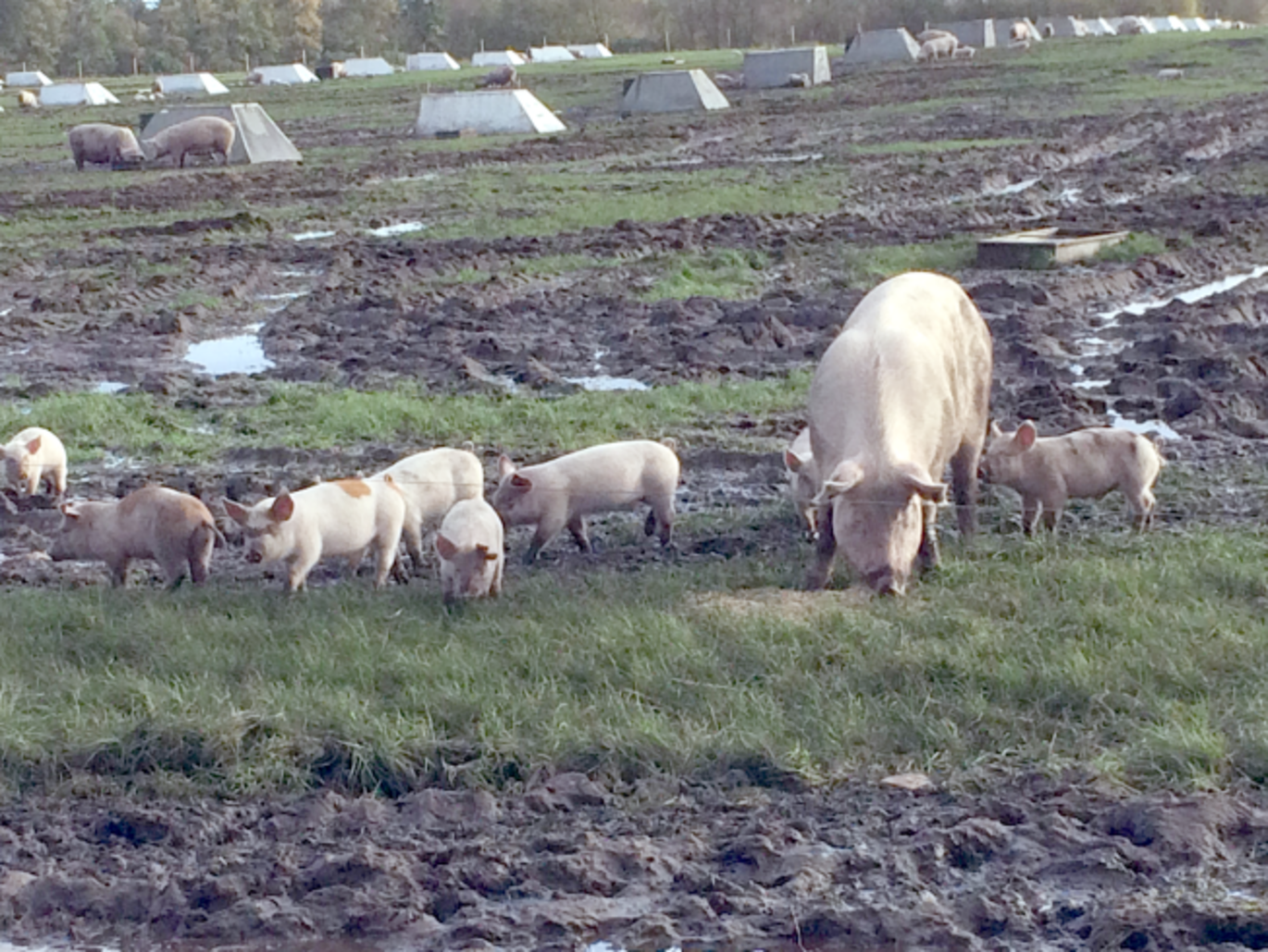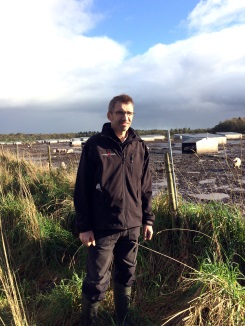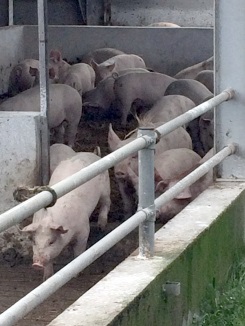Organic pig production is finding solutions to challenges
Leaching of nitrate, emission of ammonia and the weather are some of the challenges in organic pig production. Research into designing the outdoor area for growing pigs and planting trees in paddocks could potentially improve animal welfare and reduce the environmental impact.

Organic pig production is facing challenges when it comes to lessening the adverse effects on the environment. When excretory behavior of pigs is concentrated in certain areas of the paddock and on the solid floor in the outdoor run for growing-finishing pigs, problems in terms of leaching of nutrients and ammonia emission, respectively, becomes apparent. Additionally, sun and rain affect leaching and emission, while lack of shade and shelter can have a negative impact on animal welfare.
Introducing integrated production
As part of the research project pECOsystem scientists are working closely with farmers to find solutions. Organic pig producer Brian Holm, who is located in the south of Jutland in Denmark, is involved in the project. He has taken part in several research projects over the years, with which he is quite pleased.
- I’m pleased that scientists are interested in making organic pig production even more environmentally friendly and improving animal welfare. We would like to provide the pigs with the best welfare possible under controlled conditions and at the same time improve the environmental impact. Even though this means more work, it is nothing compared to the great sight when we get out to the fields and see the animals spending time amongst the trees and enjoying it, he says.
Brian Holm is one of two farmers, who has made his production available for the project.
Trees are better for the environment and for animal welfare
One way to lessen leaching of nitrate in the paddocks is to plant trees. The trees can absorb the nutrients from deep soil and they can withstand the sometimes rough handling they are exposed to by pigs. Trees also provide shade and shelter for the pigs, while also giving them the opportunity to live in an environment that more resembles their natural habitat.
However, how is their excretory behavior in the paddocks and where should trees be planted and the feed troughs be placed. These are some of the questions to which pEcosystem is trying to find answers.
 Poplar are best
Poplar are best
In order to improve the paddocks for free-range pigs the Holm-family will in the month of February plant 5-6000 poplar cuttings along the edge of the paddocks.
- We have seven children and some in-laws, so we will arrange a family gathering and start to plant the cuttings, Brian says with a smile.
Poplars will absorb some of the rainwater from the wet soil and utilize nutrients from manure and urine amongst other things. The treetops will provide shade, and when Brian has removed the lower branches, the sows cannot get hold of them for nest building inside the hut. However, sows and piglets can use the tree trunks for rubbing themselves against.
- We will make belts of poplar and grass, so the animals can have shade and rub themselves against the trees. Our idea is that, if the distance between the rows of poplar is large enough we can place the hut in between the trees. In that way the hut will be in the shade and won’t become as hot during the summer. If the hut is too warm, the sow will not spend time in there and she may farrow outside amongst the trees.
- That is not good for the piglets, as they require warmth in order to survive and to have a good start in life. Also, if the sow choose to be outside most of the time, while the piglets are inside to remain warm, then they may not be fed enough milk. Our losses become too great that way, says Brian.
In terms of excretory behavior, preliminary results indicate that, it is an advantage to place the hut close to the trees and the feed trough far from the trees. In that case, the pigs will dung near the trees.
 Willow chips as rooting material
Willow chips as rooting material
The scientists are investigating the use of willow chips as rooting material in the outdoor run of growing-finishing pigs, as it could potentially be used as roughage and have an impact on excretory behavior and pig welfare.
After willows in the farrowing paddocks have utilized nitrate from the soil to grow, the willow is harvested before it loses its leaves. This is to avoid loss of nitrate to the soil via leaves. When the pigs get the willow chips in the rooting area nitrate goes full circle in the system.
The researchers hope the pigs won’t excrete urine or manure in the enrichment area, and that they instead will use the slatted floors. If one can avoid manure and urine on the full surface floor then ammonia emission can be reduced. The results from this part of the study are not available yet, but in Brian’s outdoor run the pigs are calm and the enrichment area is thoroughly used.
Excretory behavior and walls in the outdoor run
The project team has also enriched the outdoor run with different walls placed at different angles towards the corners of the world. The purpose is to study their lying and excretory behavior and thereby reduce ammonium emission. Preliminary results indicate that the walls do have an effect, but the effect is dependent on the farm in question.
The walls can potentially also have an effect on welfare, because they provide protection from windy and sunny conditions. At Brian Holm’s farm, the pigs spend a lot of time outdoors, also during the winter. He thinks that pigs have a special need to alleviate hot conditions.
- I think in general pigs feel hot, also during the winter. Even though we find it is cold outside, pigs will chose to be outside and even use the wallowing pits during the winter, he says.
Growing pigs without tail bites
Inside the growing-finisher barn, we find calm pigs with curly tails. Brian Holm has not had problems with tail biting for a while.
- When we’ve had problems with tail biting, we have provided the animals with different types of toys such as footballs. The most effective act; however is to observe the animals and identify the animal that bites and set it out. It is time consuming, but it sorts out the problem and the pigs become calm again, he explains.
Skillful employees are indispensable
Brian Holm has 10 employees of which one is helping his wife with her organic egg layers. Each employee has his/hers own special function on the farm, for example in regards to looking after the farrowing paddock, weaners, growing pigs etc.
- Our employees are indispensable to us. They are highly skilled and want to make sure the animals are well. When we meet at lunchtime in our kitchen we talk about challenges and potential solutions - we can give each other advice and help each other. At the same time, we are all aware of what is going on in the different areas of the farm and who needs extra help, Brian Holm explains.
Skilled and enthusiastic employees is also a focus area of this project. By the use of workshops and educational material, the project staff hope to inspire agricultural students to pick organic pig production as a potential and attractive carrier.
Read more about:
***
This article was originally published in the Danish magazine HYO on January 5th 2018.
pEcosystem is founded by GUDP by the Ministry of Environment and Food of Denmark, it is a part of the Organic RDD-2 programme, coordinated by ICROFS.